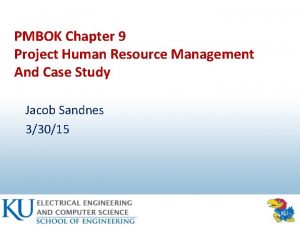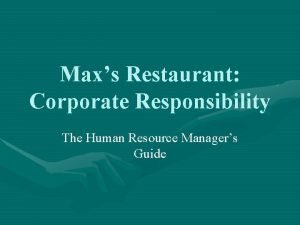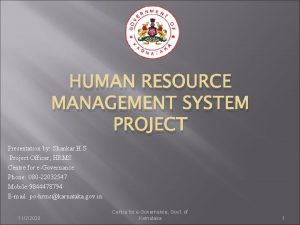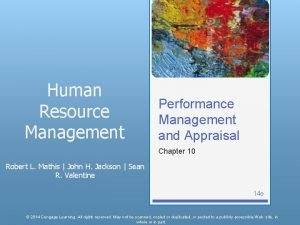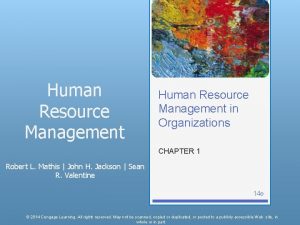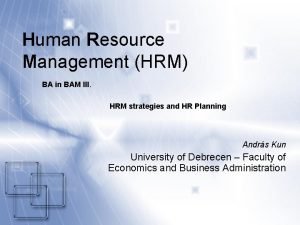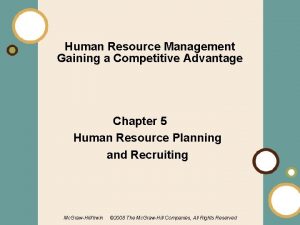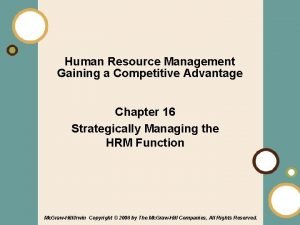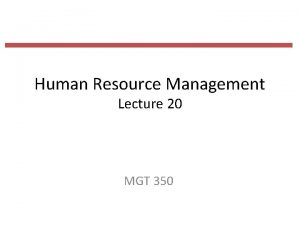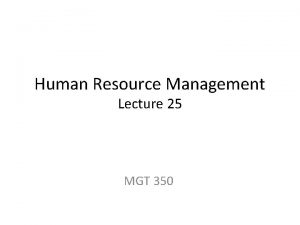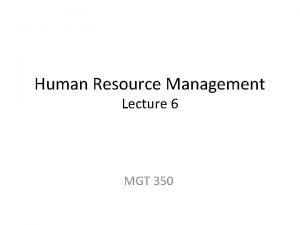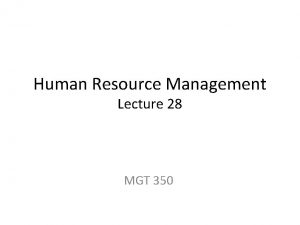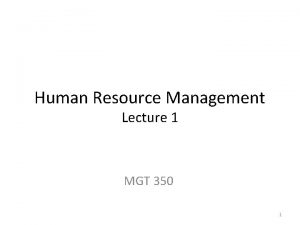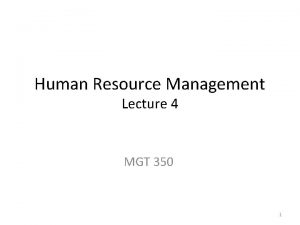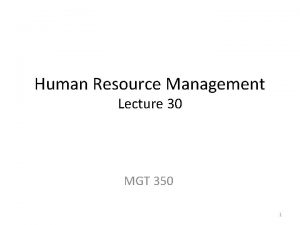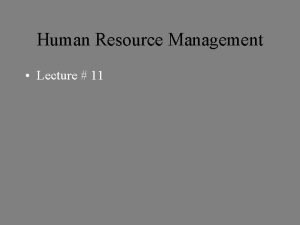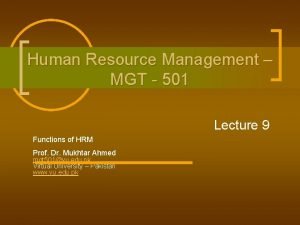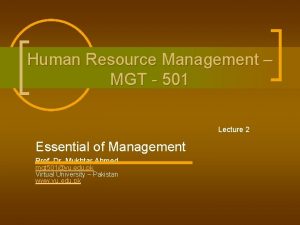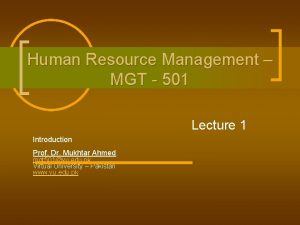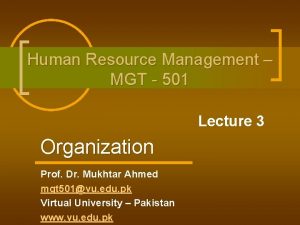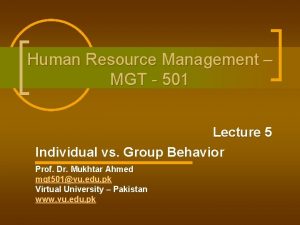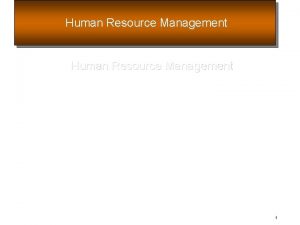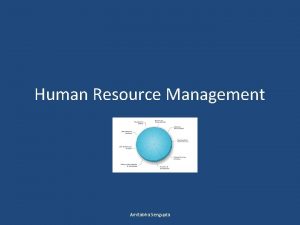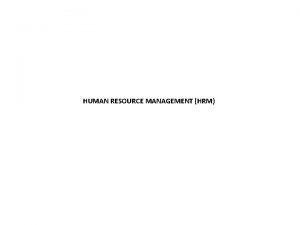Human Resource Management Lecture 11 MGT 350 Last























- Slides: 23

Human Resource Management Lecture 11 MGT 350

Last Lecture • Covers such things as: – The organization’s objectives – History – Philosophy – Procedures – Rules – HRM policies and benefits – Fellow employees

Last Lecture – CEO’s Role in orientation – HRM’s Role in Orientation • Employee training a learning experience designed to achieve a relatively permanent change in an individual that will improve the ability to perform on the job. • Determining training needs • On-the-job training methods – Job Rotation – Understudy Assignments Off-the-job training methods Lectures etc. • •

Topic Employee Development

Employee Development • Encouraging employees to acquire new or advanced skills, knowledge, and view points, by providing learning and training facilities, and avenues where such new ideas can be applied.

Employee Development Employee development methods – Job rotation involves moving employees to various positions in the organization to expand their skills, knowledge and abilities. – Assistant-to positions allow employees with potential to work under and be coached by successful managers.

Employee Development Employee development methods – Committee assignments provide opportunities for: • decision-making • learning by watching others • becoming more familiar with organizational members and problems – Lecture courses and seminars benefit from today’s technology and are often offered in a distance learning format.

Employee Development Employee development methods – Simulations include case studies, decision games and role plays and are intended to improve decision-making. – Outdoor training typically involves challenges which teach trainees the importance of teamwork.

Organization Development • What is change? • OD efforts support changes that are usually made in four areas: – The organization’s systems – Technology – Processes – People

Organization Development • Two metaphors clarify the change process. – The calm waters metaphor describes unfreezing the status quo, change to a new state, and refreezing to ensure that the change is permanent. – The white-water rapids metaphor recognizes today’s business environment which is less stable and not as predictable.

The Change Process

Organization Development OD Methods • Organizational development facilitates long-term organization-wide changes. • OD techniques include: – survey feedback – process consultation – team building – intergroup development

Organization Development • Survey feedback assesses organizational members’ perceptions and attitudes. • The summarized data are used to identify problems and clarify issues so that commitments to action can be made.

Organization Development • Process consultation uses outside consultants to help organizational members perceive, understand, and act upon process events.

Organization Development • Team building may include: – goal setting – development of interpersonal relationships – clarification of roles – team process analysis • Team building attempts to increase trust, openness, and team functioning.

Organization Development The Learning Organization • Values continued learning and believes a competitive advantage can be gained from it. • Characterized by: – capacity to continuously adapt – employees continually acquire and share new knowledge – collaboration across functional specialties – teams are an important feature

Evaluating Training and Development Effectiveness Evaluating Training Programs: • Typically, employee and manager opinions are used, – These opinions or reactions are not necessarily valid measures – Influenced by things like difficulty, entertainment value or personality of the instructor. • Performance-based measures (benefits gained) are better indicators of training’s costeffectiveness.

Evaluating Training and Development Effectiveness Performance-Based Evaluation Measures – Post-training performance method. Employees’ on-the-job performance is assessed after training. – Pre-post-training performance method. Employee’s job performance is assessed both before and after training, to determine whether a change has taken place.

Evaluating Training and Development Effectiveness Performance-Based Evaluation Measures • Pre-post-training performance with control group method. – Compares the pre-post-training results of the trained group with the concurrent job performance of a control group, which does not undergo instruction. – Used to control for factors other than training which may affect job performance.

International Training and Development Issues Cross-Cultural Training • Necessary for expatriate managers and their families: – before assignments (to learn language and culture) – during, and after foreign assignments (to adjust to changes back home).

International Training and Development Issues • Cross-cultural training is more than language training • Involves learning about the culture’s: – – – History Politics Economy Religion Social climate Business practices • May involve role playing, simulations.

International Training and Development Issues Development • Often, organizations do not do a good job of planning for the return of overseas managers. • Leads to the managers’ being frustrated • Returning expatriates can: – be assigned a domestic position – prepare for a new overseas assignment – retire or be terminated

Summary • – Encouraging employees to acquire new or advanced skills, knowledge, and view points, by providing learning and training facilities, and avenues where such new ideas can be applied. – Employee development methods – The Learning Organization – Post-training performance method. – Pre-post-training performance method – Pre-post-training performance with control group method Cross-cultural trainings involves learning about: – culture’s: § History § Politics § Economy § Religion § Social climate § Business practices
 Management fifteenth edition
Management fifteenth edition Human resource management lecture chapter 1
Human resource management lecture chapter 1 Human resource management lecture chapter 1
Human resource management lecture chapter 1 Time management human resources
Time management human resources Retail org chart
Retail org chart Role of personnel management
Role of personnel management 01:640:244 lecture notes - lecture 15: plat, idah, farad
01:640:244 lecture notes - lecture 15: plat, idah, farad Resource management pmp
Resource management pmp Project human resource management pmbok
Project human resource management pmbok Importance of personnel management
Importance of personnel management Human resource management in restaurants
Human resource management in restaurants Induction in human resource management
Induction in human resource management Human resource management chapter 2
Human resource management chapter 2 Chapter 9 human resources management
Chapter 9 human resources management Hrms shanker group
Hrms shanker group Performance appraisal in human resource management
Performance appraisal in human resource management Current issues in human resource management
Current issues in human resource management Ba human resource management
Ba human resource management Higher business management
Higher business management Human resources management gaining a competitive advantage
Human resources management gaining a competitive advantage Human resource management gaining a competitive advantage
Human resource management gaining a competitive advantage Human resource management gaining a competitive advantage
Human resource management gaining a competitive advantage Human resources management exam questions and answers pdf
Human resources management exam questions and answers pdf Human resource management fifteenth edition
Human resource management fifteenth edition








